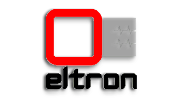LED display
ETH-2 is a specific purpose device that operates in much harsher conditions than average common goods. One of the most prominent environmental factors is the operating temperature range of the device - astronomical observatories are usually being built at mountain tops because of the clarity of the atmosphere and low light pollution, but another attribute of such locations is the fact that temperatures easily fall significantly below freezing. Having this in mind, we designed ETH-2 and all other components of AS2 system to function correctly down to -35°C. Apart from selecting premium quality electronic components, this led to a bit unusual decision of choosing 7-segment LED instead of matrix LCD type of display for ETH-2. The reason is that LCDs do not operate well (or even at all) below 0°C, but the cooler the better for good-old LEDs. When taking a look at ETH-2, those readers familiar to 80-ies flipper games might find it a bit reminiscent to animated flipper top displays, and we find this retro look quite amusing :)
The device firmware is designed so that it continuously displays measured data in cycles. Since the operator is able to customize data interpretation (in terms of
channel grouping etc), ETH-2 also has the inbuilt setup procedure for declaring type and order of displayed data with respect to it. Data itself is presented in a straightforward way - the left part of the display represents the designation of the measurement channel currently being displayed, while its numerical value is displayed in the right part of the display.
Display colour is red because it has the least negative influence on eye accomodation to darkness.

There are two conditions under which special messages are added automatically by the device to the end of each display cycle:
-
If very high humidity is detected by the special discrete rH sensor near telescope optical surfaces, message “Fog Fog” is being displayed. This input channel does not influence device operation in any other way and cannot be used as a condition for initiating protective function outputs, but simply serves as a warning to the operator that very high air humidity is detected. The same message is simultaneously displayed by the PC application software.
-
If estimated internal Li-ION accumulator energy has fallen below 50% of its full capacity, a report is displayed. It has the form “Accu XY.z%” and should serve as a warning to the operator that device autonomy might be limited.
Due to the fact that dome illumination varies from complete darkness to practically daylight strength, we enabled easy LED display brightness setting in a very broad 1:250 range. But because dome illumination might change rapidly (for example while telescope is being set up and tested by the stuff), ETH-2 has an inbuilt illumination sensor and can automatically regulate its display brightness. In that case, operator sets only the approximate relative brightness of the display she or he finds most appropriate and lets the device adjust the absolute brightness according to the current environmental illumination so that the display brightness perceptually stays the same. Finally, because no photons should be emitted inside the dome when astronomical cameras are active, ETH-2 can completely turn its display off. When it is put in this “optically silent” mode, a button press by the operator calls only for a single data cycle to be displayed.
The described display control might sound a bit complicated, but we put our best efforts to predict all typical situations the observatory stuff might find themselves in and to design ETH-2 so that it suits them best and as intuitively as possible.
Remote console
Although connecting it to a central computer via ELM-4 data bus is preferred mode of operating ETH-2 remotely, the device also enables connecting a small remote console to its special console port. The console contains an LED display that replicates information that otherwise would be displayed on ETH-2 internal display, and a simple keyboard identical to ETH-2 internal one. This way, telescope operator can access all device functions from the distance up to 15 m away, which might prove useful in case that there is no operative ELM-4 data link availabe.

